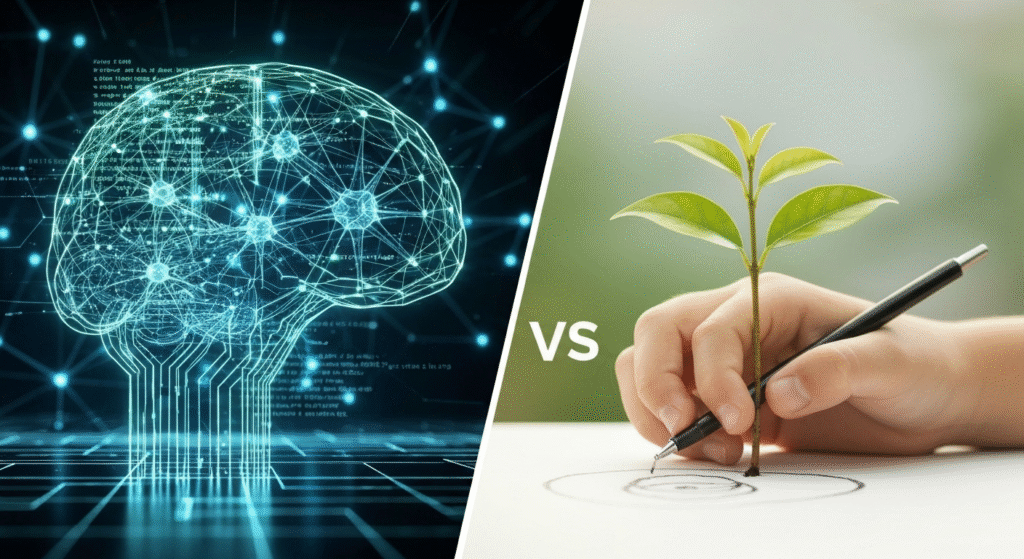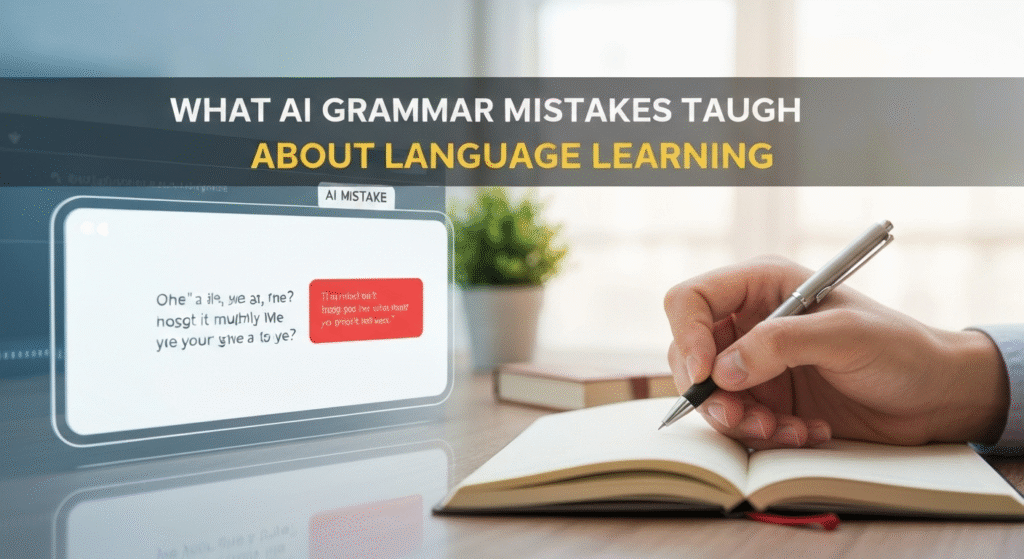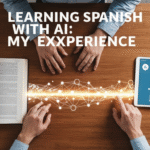It’s a familiar feeling for anyone who uses AI tools. You get a response that’s almost perfect, but one sentence just feels… off. It might be grammatically correct in a strict, textbook sense, but no native speaker would ever say it that way. For a long time, I’d just correct it and move on. But then I started paying closer attention. I realized these little stumbles and awkward phrases weren’t just glitches. They were fascinating clues into the difference between processing language and truly understanding it.
These AI grammar mistakes have become an unexpected classroom for me. They offer a unique window into how artificial intelligence “thinks” about language, which in turn has revealed so much about how we humans learn it. By looking at where the machines go wrong, we can better understand what we do right, often without even realizing it. This article is a journey through my personal observations, documenting the patterns I found in AI errors and the surprising linguistic lessons they taught me along the way.
My name is Zain Mhd, and for the past five years, my work has involved exploring the practical applications of artificial intelligence. This journey hasn’t been about abstract code but about seeing how these complex systems interact with something deeply human: language. My curiosity led me to start documenting the peculiar grammar and phrasing from various AI models. I wasn’t just proofreading; I was investigating. This passion for understanding the “why” behind AI’s linguistic quirks is what I aim to share here, offering a clear look into what these advanced tools can teach us about our own path to fluency.
The Starting Point: Noticing Patterns in AI Errors

My experiment began informally. I started a simple document where I’d paste odd sentences generated by AI writing assistants, chatbots, and translation tools. Soon, what started as a random collection of errors began to show clear and repeatable patterns. It was like seeing the ghost in the machine—the underlying logic that caused these tools to trip up in very specific, predictable ways. These weren’t random bugs; they were symptoms of how an AI fundamentally processes words.
The errors weren’t usually simple typos or incorrect verb conjugations. In fact, most AI models have mastered basic syntax. The mistakes were far more subtle and interesting, revealing a gap between knowing the rules of grammar and understanding the art of communication. Here are the three main categories of mistakes I encountered time and time again.
The Case of the Clumsy Idiom
One of the first patterns I noticed was AI’s struggle with idiomatic expressions. An idiom is a phrase where the meaning isn’t deducible from the literal definitions of the words. Think of phrases like “bite the bullet” or “the ball is in your court.” Humans learn these through cultural context. AI, however, often learns them as statistical correlations of words.
I once saw an AI describe a difficult decision by saying, “It was time to seize the bull by its horns.” While technically correct, a native English speaker would almost always say “take the bull by thehorns.” The AI chose a synonym (“seize” instead of “take”) that was grammatically sound but stylistically alien. This revealed a key insight: the AI didn’t understand the phrase as a single, unchangeable unit of meaning. It saw it as a collection of individual words that could be swapped out, missing the point that idioms are often frozen in place by convention.
Context Blindness and Pronoun Problems
Another frequent issue was a breakdown in contextual understanding over longer stretches of text. An AI could write a perfect paragraph, but by the third or fourth paragraph, it would start losing track of the subject. Pronouns like “it,” “he,” and “they” would suddenly refer to the wrong noun, creating confusion.
For example, I was reading an AI-generated summary of a historical event involving a general and his army. It started clearly, but then a sentence popped up: “After they captured the city, it was exhausted and needed to regroup.” What was exhausted? The city? The army? A human writer would instinctively keep the subject clear, but the AI’s attention drifted. This happens because many models have a limited “context window”—they can only “remember” a certain amount of recent text. Once the original subject is outside that window, the AI can get lost, just like someone walking into a room and forgetting why they are there.
Overly Formal and Unnaturally Polite Language
This is perhaps the most common and subtle error. AIs are often trained on massive datasets that include formal documents, academic papers, and encyclopedias. As a result, they tend to adopt an overly formal and polite tone, even in situations that call for casual language.
I once asked a chatbot a simple question about a movie, and it responded, “It is my determination that the cinematic feature you are referring to is indeed a noteworthy piece of filmmaking.” No human talks like that. We’d say, “Yeah, that’s a great movie!” This tendency to default to a formal register shows that the AI isn’t making a conscious choice about tone. Instead, it’s regurgitating the most statistically common patterns from its training data, which often lean toward formal language. It lacks the social awareness, or pragmatics, to know when to loosen up.
AI’s Logic vs. Human Intuition: A Tale of Two Learners

Observing these patterns made me realize that AIs and humans learn language in fundamentally different ways. It’s not just a matter of scale or speed; it’s a completely different philosophical approach. An AI learns by analyzing trillions of data points and identifying statistical probabilities. It’s a master of patterns. A human, on the other hand, learns through lived experience, social interaction, and a deep-seated desire to connect with others.
Let’s break down this comparison. An AI model like GPT-4 is trained by being shown a massive amount of text from the internet. It learns that after the words “the cat sat on the,” the next word is very likely to be “mat.” It doesn’t know what a cat is, what a mat is, or what sitting is. It just knows the statistical relationship between those words. Its “understanding” is a complex web of mathematical probabilities.
A child, however, learns by pointing at a furry creature and hearing their parent say “cat.” They feel its soft fur, watch it pounce, and connect the word to a rich set of sensory experiences. When they learn the phrase “the cat sat on the mat,” they understand the intent behind it—a statement about a real-world action. This difference in learning methodology is the root cause of AI’s specific brand of errors. They make mistakes that are logically sound but experientially wrong.
| Feature | AI Language Processing | Human Language Learning |
| Learning Method | Statistical pattern recognition from vast text data. | Immersion, social interaction, trial-and-error in real-world contexts. |
| Understanding | Based on probability and word associations. | Based on intent, context, emotional cues, and sensory experience. |
| Common Error Type | Logically plausible but contextually or culturally incorrect. | Overgeneralization of rules (e.g., “I goed” instead of “I went”). |
| Creativity | Can recombine existing patterns in novel ways. | True creativity; can invent new concepts and expressions from experience. |
| Nuance | Struggles with sarcasm, humor, and subtle cultural subtext. | Mastered through years of social and cultural immersion. |
This table highlights the core difference: AI is a brilliant statistician, while a human is a social participant. This is why AI can write a perfect scientific abstract but fails at writing a heartfelt, convincing apology. The first is about information patterns, the second is about genuine emotional intent.
Key Linguistic Lessons Gleaned from AI Flaws
Analyzing these AI failures wasn’t just a fun exercise in tech critique. It provided me with profound lessons about the nature of language itself—lessons that are often overlooked in traditional language classes. Here’s what stood out.
Lesson 1: Pragmatics is King
I quickly learned that grammar (syntax) is only a small part of communication. The real magic happens with pragmatics—the study of how context influences meaning. An AI might produce a sentence that is 100% grammatically correct, but if it’s delivered in the wrong context, it fails completely. The AI’s formal tone in a casual chat is a pragmatic error, not a grammatical one.
This realization shifted my own language-learning focus. I stopped worrying so much about memorizing every single grammar rule and started paying more attention to how native speakers use language in different social situations. When do they use slang? When do they opt for formal language? Understanding the unwritten social rules of a language became more important than just knowing how to conjugate verbs.
Lesson 2: The Power of “Chunks” and Collocations
Humans don’t process language word by word. We think and speak in “chunks”—groups of words that commonly go together. These are known as collocations. For example, we say “heavy rain,” not “strong rain,” and we “make a decision,” not “do a decision.” AI’s awkward phrasing often comes from breaking these natural word pairings. It might choose a synonym that is technically correct but just sounds wrong to a native ear because it violates a common collocation.
This taught me to learn vocabulary differently. Instead of memorizing single words, I now focus on learning word chunks. I use flashcards for phrases like “to be interested in,” “on the other hand,” or “to take advantage of.” This method has made my speaking and writing sound much more natural and fluent, as I’m using the same building blocks that native speakers use.
Lesson 3: The Unspoken Rules of Culture
AI’s repeated failures with idioms, sarcasm, and cultural references were a stark reminder that language is inseparable from culture. To truly master a language, you need to understand the shared history, values, and experiences of the people who speak it. The AI, lacking any lived experience, can only access a shallow, surface-level version of this cultural context.
This pushed me to engage more deeply with the culture of the languages I’m learning. I started watching movies without subtitles, listening to popular music, and reading blogs on topics I enjoy. This wasn’t just for practice; it was for cultural immersion. Learning why a certain joke is funny or understanding a historical reference in a news article is just as important as learning vocabulary. AI’s mistakes showed me that without this cultural dimension, fluency is impossible. For a deep dive into this connection, the field of sociolinguistics offers fascinating insights.
How This Changed My Own Approach to Language Learning

These insights didn’t just stay theoretical. They actively reshaped my personal strategies for learning and using languages. The perspective I gained from watching AI fail has made me a more effective and confident language learner.
First and foremost, it helped me embrace imperfection. If a multi-billion dollar AI model can make silly mistakes, then it’s perfectly fine for me to do so as well. This took a lot of the pressure off. I became less afraid of speaking and making errors, understanding that the primary goal is communication, not perfection.
This led to a new focus on communication over correction. In the past, I would get bogged down by trying to form the perfect sentence. Now, I prioritize getting my message across, even if it’s not grammatically flawless. I realized that context and intent can often make up for grammatical shortcomings, something AI struggles with.
Finally, I learned to use AI as a specific tool, not a universal teacher. It’s not great for learning the nuances of conversation or culture. However, it’s an excellent assistant for specific tasks.
Here is my current AI-assisted workflow:
- I start by writing a practice paragraph in my target language, focusing on expressing my thoughts clearly.
- Then, I ask a tool like ChatGPT or Claude to “make this sound more natural for a native speaker.”
- I carefully analyze the changes it suggests. Did it swap out a word for a better collocation? Did it restructure a sentence to flow better?
- Most importantly, I don’t just blindly accept the changes. I ask the AI why it made them. For example: “Why is ‘heavy rain’ better than ‘strong rain’ in this context?”
This process turns the AI from a simple proofreader into a Socratic partner. It helps me identify the gaps between my textbook knowledge and real-world usage, making my learning far more targeted and effective.
Frequently Asked Questions (FAQs)
What’s the most common grammar mistake you see AI make?
The most frequent error isn’t a strict “grammar” mistake but a stylistic or pragmatic one. AIs constantly use an overly formal tone and choose words that are technically correct but unnatural. For example, using “utilize” instead of “use” or “commence” instead of “start” in a casual sentence.
Can I rely on AI for accurate translations?
For literal, informational text, AI translation is incredibly powerful and generally reliable. However, for anything with cultural nuance, humor, marketing copy, or emotional weight, it should be used with extreme caution. It often misses the subtext and can produce translations that are technically correct but emotionally or culturally tone-deaf.
Is AI a good tool for learning a new language?
Yes, but it should be used as a supplement, not a primary teacher. It’s excellent for practicing writing, getting suggestions for more natural phrasing, and asking specific grammar questions. It is not a good replacement for interacting with native speakers or immersing yourself in the culture.
How can I spot AI-generated text?
Look for the patterns mentioned in this article. Does the text have a slightly robotic, overly formal tone? Does it lack personal anecdotes or emotional depth? Does it sometimes use strange or slightly “off” word choices? While AI is getting better at hiding these tells, they are often still present upon close inspection.
Conclusion
My journey into the world of AI’s linguistic blunders has been one of the most enlightening experiences in my language-learning career. What began as a simple curiosity about technical errors evolved into a deeper appreciation for the complexity and beauty of human communication. The mistakes made by these powerful algorithms serve as a constant reminder that language is more than a system of rules; it’s a living, breathing reflection of our culture, our experiences, and our shared humanity.
The key takeaway is this: AI’s weaknesses highlight our strengths. Its struggle with pragmatics underscores the importance of social context. Its clumsy phrasing reveals the power of learning in chunks and collocations. And its cultural blindness proves that language and culture are two sides of the same coin. For fellow language enthusiasts, my advice is to pay attention to these robotic mistakes. They are not just errors to be corrected; they are guideposts pointing us toward what truly matters in the quest for fluency.



Pingback: Earn Money From Google AdSense Step by Step Guide in 2026